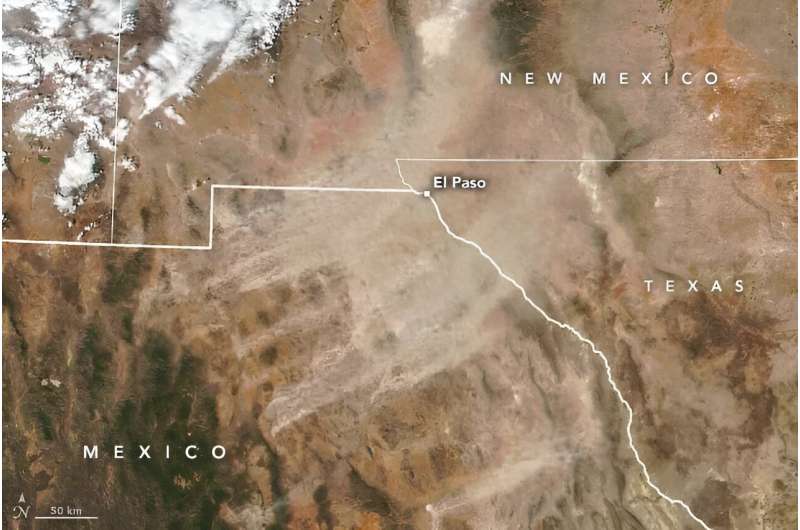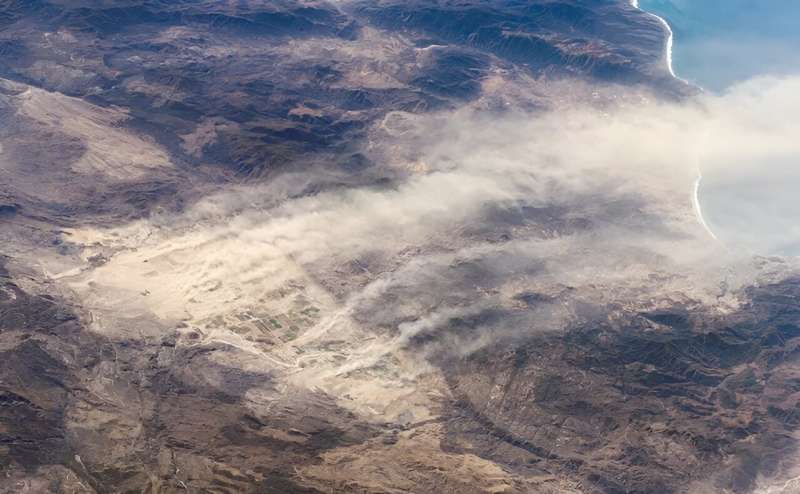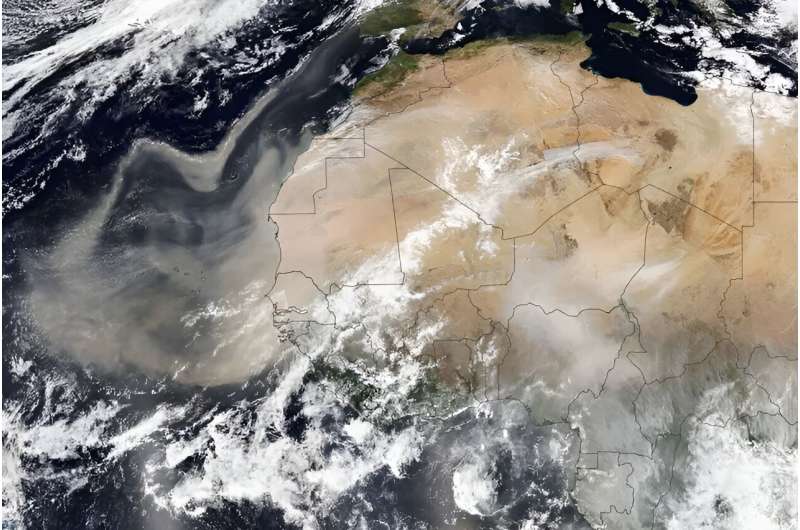This article has been reviewed according to Science X's editorial process and policies. Editors have highlighted the following attributes while ensuring the content's credibility:
fact-checked
trusted source
proofread
Satellite data can help limit the dangers of windblown dust

Interstate 10, an artery that cuts through the rural drylands of southern New Mexico, is one of the country's deadliest roadways. On one stretch of the highway, just north of a dry lakebed called Lordsburg Playa, fatal collisions occur with such regularity that officials often call it the "dust trap." It's a fitting name. Since 1967, at least 55 deaths in the area have been linked to dust storms.
This stretch of Interstate 10 offers a concentrated example of the hazards that dust storms carry. But across the U.S. Great Plains, levels of windblown dust have increased steadily, by about 5% each year between 2000 and 2018, contributing to a decline in air quality and an increase in fatal collisions.
"Dust storms are appearing with greater frequency for reasons that include extended drought conditions and urban sprawl, which disrupt the fragile biotic crust of the desert," said John Haynes, program manager for NASA's Health and Air Quality Applied Sciences Team. As reduced rainfall in arid regions and warmer weather become regular fixtures of the U.S. climate, experts expect the trend to continue.
On the ground, dust storms form menacing palls that can swallow entire cities whole. From space, dust storms can be observed moving across continents and oceans, revealing their tremendous scale. It's from this vantage point, high above the clouds, that NASA and NOAA have Earth-observing satellites that help scientists and first responders track windblown dust.
Daniel Tong, professor of atmospheric chemistry and aerosols at George Mason University, working closely with NASA's Health and Air Quality Applied Sciences Team, leads a NASA-funded effort to improve the country's dust forecasting capabilities. Tong's forecasting system relies on an algorithm called FENGSHA, which means "windblown dust" in Mandarin.
By plugging real-time satellite data into a complex model of Earth's atmosphere—one that accounts for site-specific variables like soil type, wind speed, and how Earth's surface interacts with winds—the system churns out hourly forecasts that can predict dust storms up to three days in advance.
FENGSHA was initially developed using a dust observation method trained by NASA's Aqua and Terra satellites. It's these "space truths," as Tong calls them, that make reliable forecasting possible. Comparing the model's predictions with satellite imagery from real dust storms allows the team to identify shortcomings and improve accuracy. The most recent version of the model includes data from the Visible Infrared Imaging Radiometer Suite (VIIRS) on the NASA-NOAA Suomi-NPP, NOAA-20, and NOAA-21 satellites, which observe each location on the planet at least twice a day.
Currently, the dust monitoring system is available to all 122 of the National Weather Service's regional forecasting offices. When a forecast calls for dust, local teams assess each case individually and decide whether to send out alerts. These could involve a warning to transit authorities or weather alerts sent directly to people's phones.
"Dust storms cause traffic accidents, negatively impact air quality, and even carry pathogens that cause diseases," Haynes said. "Early warning systems empower individuals to take necessary actions, such as sheltering indoors or clearing roadways until the storm passes."

The benefits of early warning
On May 1, 2023, high winds in Illinois sent a dark cloud of dust creeping along Interstate 55, the state's main throughway. Visibility was reduced to zero in a matter of minutes—leaving drivers with little time to react. The resulting collision involved 72 vehicles and killed eight people. Dozens more were hospitalized.
In some hotspots for dust, officials are taking steps to minimize the damage. On Interstate 10 in New Mexico and Arizona, for example, drivers are now met with 100 miles of roadside warning signs that urge them to pull over when dust is detected. But Interstate 55, in Illinois, isn't a hotspot. No one saw the storm coming. And as dust claims new territory, local ground-based solutions may not provide sufficient coverage.
This is why satellite-based forecasting is essential, said Morgan Gorris, an Earth system scientist and geohealth expert at Los Alamos National Laboratory. "When we see a dust storm developing in radar returns or on dust sensors, people are already on the road, and it's more difficult to make safety decisions."
Tong hopes to see forecasts used more frequently in commercial trucking "to prevent delays, traffic jams, and accidents," he said. Notably, semi-trucks or tractor-trailers are involved in almost all fatal collisions involving dust. By rerouting or delaying truck drivers, the worst accidents could be avoided.
Tong also promotes advanced forecasting as a way to reduce the frequency and intensity of dust storms. Storms like the one in Illinois—which rose from the overworked soil of the surrounding farmland—might be preventable. "If we know that there might be a dust storm tomorrow, farmers might stop tilling their land," he said.
Most fatal collisions are the result of smaller, quick-forming dust storms. But larger storms carry additional hazards. Billowing plumes of dust lofted from loose soil or desert floors by high-speed winds can reach thousands of feet into the air and travel hundreds of miles, affecting the respiratory health of populations across great distances.
Valley fever—an infectious disease caused by a soil-dwelling fungus endemic to the arid and semi-arid climates of Texas, New Mexico, Arizona, and California—is also a threat. The fungus is harmless in the ground, but airborne spores can lead to infections that are sometimes fatal. The Centers for Disease Control and Prevention reported more than 200,000 infections of Valley fever since 1998. The current infection rate is about 10 times higher than that of the West Nile Virus, a vector-transmitted disease that often receives far more attention.

"The areas where we see dust storms and the areas endemic to Valley fever are both expanding," said Gorris, who also warns that the expanding reach of dust storms might unearth new airborne diseases. "We don't yet know what other biology is in the soil that might infect us."
It's not just what's in the soil. Even when traces of chemical or biological toxins are absent, the soil itself can be a significant irritant. "People think that it's a natural phenomenon carrying natural material, so it's probably innocuous," said Thomas E. Gill, professor of Earth and environmental sciences at the University of Texas at El Paso. But that's not the case. Fine grains of dust can penetrate deep into lung tissue and are linked to an increase in respiratory illness and premature death.
According to a global study conducted by atmospheric scientists at NASA's Goddard Space Flight Center, 2.89 million premature deaths were connected to PM2.5 in 2019—and 22% of those deaths were attributed to dust. Most at risk were children and those with pre-existing conditions like asthma.
A new way to see an old problem
In the 1930s, during the Dust Bowl years, severe drought and poor land management sent deadly "black blizzards'' sweeping across the landscape. From Texas to Nebraska, wind stripped the soil of vital nutrients, generating massive dust storms that blocked out the sun for days at a time and reached as far east as New York City—where the sky was dark enough for streetlights to switch on in the middle of the day.
Some scientists claim that the threat of a "dust bowl 2.0" is imminent. Urban sprawl, industrial-scale agriculture, wildfires, drought, and a warming climate can all strip the land of vegetation and remove moisture from the soil. But it can be difficult to draw a hard line from these individual sources to their cumulative effects. "We have to continue developing our understanding of the consequences on our communities and come up with better ways to protect citizens," Tong said.
The next generation of FENGSHA will soon be integrated into an atmospheric model developed by NASA called the Goddard Chemistry Aerosol Radiation and Transport (GOCART). Features of Earth's surface like rocks, vegetation, and uneven soil all influence how much dust the wind can kick up. As a result, both the amount of dust in the air and the direction that windblown dust travels are often governed by what's on the ground.
GOCART's ability to model these surface features will improve the accuracy of the forecasting system, said Barry Baker, an atmospheric physicist and lead of chemical modeling for the National Oceanic and Atmospheric Administration who led the research to operation transition of FENGSHA for NOAA's oceanic and atmospheric research team. The ultimate goal, though, he added, is a geostationary satellite. Polar-orbiting satellites pass over each spot of the globe twice a day; a geostationary satellite could hover over the U.S. and monitor dust around the clock, tracking storms as they develop and grow.
Despite its hazards, windblown dust is a fundamental feature of the atmosphere and a critical ingredient for life on Earth. Dust from the Saharan Desert carries life-sustaining nutrients across the Atlantic Ocean to the Amazon rainforest, roughly 1,600 miles away. It also feeds the vast algal ecosystems that teem near the surface of Earth's oceans, which in turn support a diverse menagerie of marine life. Even if we could rid the planet of dust, we would not want to.
"There's no way to contain the situation; you can't just eliminate the desert," Tong said. "But what we can do is increase awareness and try to help those who are impacted most."
Provided by NASA




















